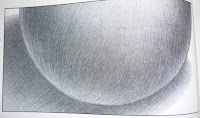There are a few terms you need to know, like geometric perspective (sometimes called linear perspective) this is the effect that shows the subject(s) appearing smaller the further away they are from you. Horizon Line, this is the imaginary line that divides your vision when you look straight ahead, where the earth and sky meet. Perspective Lines, are straight lines drawn at an angle from the edge of the objects, back into perceived distant space until the finally converge at a point on the horizon line (this was taken straight out the book as I have no other way of trying to explain it to you), these lines act as guides to help draw objects in proper perspective. Lastly is the vanishing point, again taken directly from the book, the point on the horizon line where the angular perspective lines of an object visually continue past it’s edges and eventually converge. Shoo... Hanging in there? Don't worry it will all make sense in a moment when you see the pictures.
Next we begin to understand that as the drawer you control the eye level view of the viewer. By changing the horizon line you change the perspective of your drawing, change weather the objects are seen from above, below, or at eye level. Below are pictures that Brenda has drawn to demonstrates this.
 |
| Objects seen from below and above |
 |
| Objects seen at eye level view |
 |
| Take you picture and draw the lines you see |
 |
| Then extend those lines until they all converge and this will be your vanishing point |
Other factors to take into consideration are atmospheric perspective (aka - aerial perspective) this effect makes the object in your pictures appear lighter and faded as they disappear into the distance and lastly we have foreshortening, this is described as follows: ‘’As the angle of viewing becomes more extreme, visual distortion becomes more pronounced.'' Below is an image that demonstrates this, but you must assume that all the bars are of equal length:
 |
| Objects seen straight on will visual distort |
I hope you didn't find this section to confusing, I think perspective is something that you will need to practise and read about a few times before it finally sinks in and makes sense, at least that's how I feel. Hopefully the above made a little sense and has helped in bridging a few gaps. Next we start Part 3 of the book - Time to start drawing! Can’t wait.
(Please note: that photo examples are taken from "Drawing for Dummies by Brenda Hoddinott'' and the above views are not representative of her and are purely based on a 3rd party view being Me! All snippets taken directly from the book are stated as been so)

















